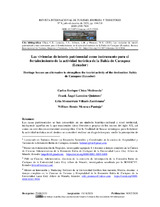Mostrar el registro sencillo del ítem
Las viviendas de interés patrimonial como instrumento para el fortalecimiento de la actividad turística de la Bahía de Caraquez (Ecuador)
| dc.contributor.author | Chica Medranda, Carlos Enrique | |
| dc.contributor.author | Lemoine Quintero, Frank Angel | |
| dc.contributor.author | Villacís Zambrano, Lilia Monserrate | |
| dc.contributor.author | Meneses Pantoja, William Renán | |
| dc.date.accessioned | 2021-01-12T12:55:40Z | |
| dc.date.available | 2021-01-12T12:55:40Z | |
| dc.date.issued | 2020 | |
| dc.identifier.issn | 2530-7134 | |
| dc.identifier.uri | http://hdl.handle.net/10396/20964 | |
| dc.description.abstract | Las casas patrimoniales se han convertido en un símbolo histórico-cultural a nivel territorial, incluyendo aquéllas en la que trascienden ideas liberales y propias de los inicios del siglo XX, así como un aire desconocidamente cosmopolita. Con la finalidad de buscar estrategias para fortalecer la actividad turística en el destino se consideró realizar un diagnóstico para medir la percepción de los turistas que asisten a la localidad referente a sus criterios de las casas patrimoniales y su estado de conservación. El método descriptivo admitió fundamentar criterios partiendo de los resultados arrojados por el REDATAM demostrando que estas construcciones marcaron en el desarrollo cultural de la región y por ende en las casas patrimoniales. El principal resultado es desarrollar planes de contingencias para afrontar estrategias de reconstrucción de las casas patrimoniales para el fortalecimiento de la actividad turística en el destino. | es_ES |
| dc.description.abstract | The heritage houses have become a cultural historical symbol at the territorial level, where they transcend these from the first settlements and emigrations that arrived in the country, giving it liberal ideas at the beginning of the 20th century and a cosmopolitan air, in order to seek strategies to strengthen the tourist activity in the destination, it was considered to carry out a diagnosis to measure the perception of tourists who attend the town regarding their criteria of heritage houses and their state of conservation. The descriptive method allowed to base criteria based on the results produced by REDATAM demonstrating that these constructions marked the cultural development of the region and therefore the heritage houses. The main result is to develop contingency plans to face reconstruction strategies for heritage houses to strengthen tourist activity in the destination. | es_ES |
| dc.format.mimetype | application/pdf | es_ES |
| dc.language.iso | spa | es_ES |
| dc.publisher | UCOPress | es_ES |
| dc.rights | https://creativecommons.org/licenses/by-nc/4.0/ | es_ES |
| dc.source | Revista Internacional de Turismo, Empresa y Territorio (RITUREM) 4(2), 194-211 (2020) | es_ES |
| dc.subject | Casas patrimoniales | es_ES |
| dc.subject | Diagnóstico | es_ES |
| dc.subject | Conservación | es_ES |
| dc.subject | Actividad turística | es_ES |
| dc.subject | Bahía de Caráquez (Ecuador) | es_ES |
| dc.subject | Heritage houses | es_ES |
| dc.subject | Diagnosis | es_ES |
| dc.subject | Conservation | es_ES |
| dc.subject | Tourist activity | es_ES |
| dc.title | Las viviendas de interés patrimonial como instrumento para el fortalecimiento de la actividad turística de la Bahía de Caraquez (Ecuador) | es_ES |
| dc.title.alternative | Heritage houses an alternative to strengthen the tourist activity of the destination Bahía de Caraquez (Ecuador) | es_ES |
| dc.type | info:eu-repo/semantics/article | es_ES |
| dc.relation.publisherversion | http://www.uco.es/ucopress/ojs/index.php/riturem/index | es_ES |
| dc.rights.accessRights | info:eu-repo/semantics/openAccess | es_ES |

